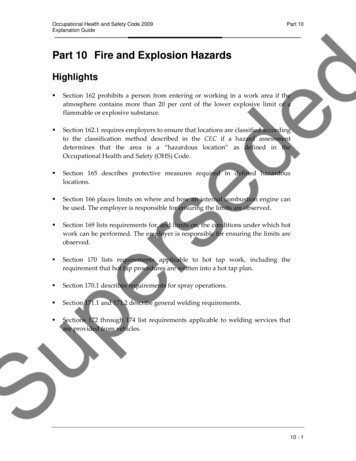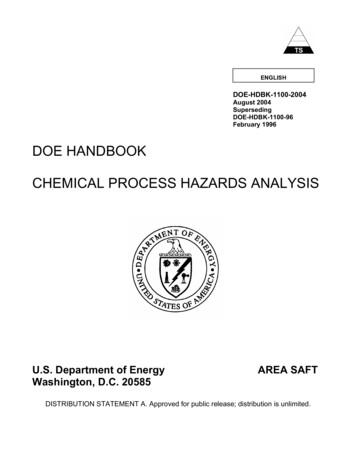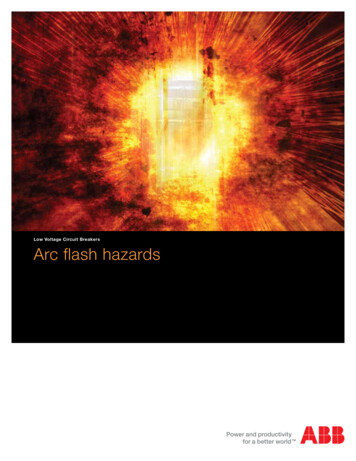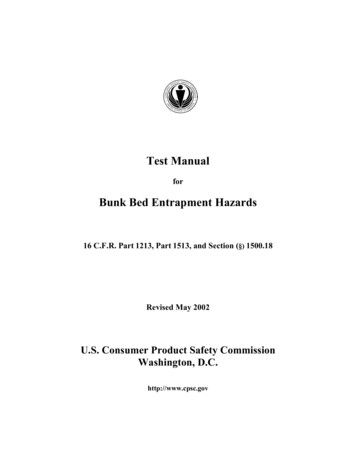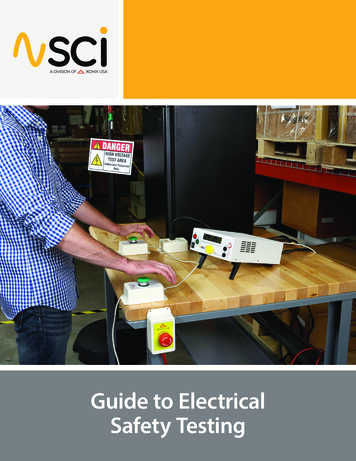
Transcription
ELECTRICAL SAFETY HAZARDS HANDBOOK
The World’s Leading Provider ofCircuit Protection SolutionsLittelfuse is the global leader in circuit protectionA comprehensive approach to circuit protectionCompanies around the world have come to rely onLittelfuse’s commitment to providing the most advancedcircuit protection solutions and technical expertise. It’s thisfocus that has enabled Littelfuse to become the world’sleading provider of circuit protection solutions.Littelfuse goes well beyond efficient and comprehensiveproduct delivery. We offer an integrated approach to circuitprotection that includes:For over 75 years, Littelfuse has maintained its focus oncircuit protection. As we expand in global reach and technicalsophistication, you can continue to count on us for solid circuitprotection solutions, innovative technologies, and industryleading technical expertise. It is a commitment that only aworld class leader with staying power can support. A very broad, yet deep selection of productsand technologies from a single source, so youbenefit from a greater range of solutions andmake fewer compromises. Products that comply with applicable industryand government standards, as well as our ownuncompromising quality and reliability criteria. Forward thinking, application-specific solutionsthat provide the assurance your most demandingrequirements will be met. Dedicated global, customer-focused andapplication-specific technical support services.
Littelfuse Electrical Safety HAZARDS HandbookLittelfuse is Committed to SafetyLittelfuse has a continuing commitment to improvedelectrical safety and system protection. As the leader incircuit protection, Littelfuse offers a variety of products andservices designed to help you increase safety in your facility.For assistance with Arc-Flash, products and services, orapplication information, call 1-800-TEC-FUSE (832-3873).Electrical Safety is a Serious IssueElectrical Safety in the workplace is the most importantjob of an electrical worker. No matter how much trainingone has received or how much employers try to safeguardtheir workers, Electrical Safety is ultimately the responsibility of the electrical worker. The human factor associatedwith electrical accidents can be immeasu rable. No one canreplace a worker or loved one that has died or suffered theirreparable consequences of an electrical accident.This Electrical Safety Hazards Handbook was developed for general education purposes only and is not intendedto replace an electrical safety-training program or to serve as a sole source of reference. The information herein isalso not intended to serve as recommendations or advice for specific situations. It is the responsibility of the user tocomply with all applicable safety standards, including the requirements of the U.S. Occupational Safety and HealthAdministration (OSHA), the National Fire Protection Association (NFPA), and other appropriate governmental andindustry accepted guidelines, codes, and standards. Use the information within this Handbook at your own risk.
Table of ContentsIntroductionWhy is Electrical Safety so Important?Electricity BasicsOhm’s LawTypes of Electrical FaultsOverloadsShort CircuitsOvercurrent Protective DevicesInterrupting RatingCurrent LimitationFusesCircuit BreakersCircuit Protection ChecklistHistory of Electrical SafetyElectrical Safety OrganizationsOSHAThe General Duty ClauseOSHA RegulationsNFPAIEEENRTLNEMAANSIASTMNECAElectrical Safety Codes and StandardsWorking on Deenergized EquipmentEstablish a Safe Work ConditionWorking on Energized 122222223Who is Qualified?Energized Electrical Work PermitEmployer and Employee Responsibilities242426Arc-Flash and Other Electrical Safety Hazards 27Electrical Safety HazardsElectric ShockArc-Flash and Arc BlastsArc-Flash MetricsArc-Blast EffectLight and Sound Effects272728293131Electrical Hazard Analysis32Shock Hazard AnalysisApproach BoundariesFlash Hazard AnalysisArc-Flash CalculationsArc-Flash Hazard Calculation ExamplesIEEE 1584 Arc-Flash Hazard CalculationNFPA 70E Table MethodSteps Required to Use theNFPA 70E Table MethodMinimizing Arc-Flash and OtherElectrical Hazards1. Design a Safer System2. Use and Upgrade to Current-limitingOvercurrent Protective Devices3. Implement an Electrical Safety Program4. Observe Safe Work Practices5. Use Personal Protective Equipment (PPE)6. Use Warning Labels7. Use an Energized Electrical Work Permit32323435363840404242434545474949
8. Avoid Hazards of Improperly Selected orMaintained Overcurrent Protective Devices9. Achieve or Increase Selective Coordination5051Electrical Safety Summary53Annex A54Electrical Safety Terms and DefinitionsAnnex BElectrical Safety Codes and StandardsAnnex CEnergized Electrical Work PermitAnnex DArc-Flash Calculation StepsAnnex EArc Flash Calculator TablesAnnex FResources for Electrical SafetyAnnex GReferencesAnnex HElectrical Safety Quiz546161636365656767717173737474
IntroductionElectrical Safety Hazards Overview97%of allelectricianshave beenshocked orinjuredon the job.Safety in the workplace is job number one foremployer and employee alike. It is especiallyimportant for those who install and serviceelectrical systems. Nothing can replace aworker or loved one that has died or sufferedthe irreparable consequences of an electricalaccident. No matter how much an employertries to safeguard its workers or how muchsafety training is provided; the ultimateresponsibility lies with the worker. The humanfactor is part of every accident or injury.The purpose of this handbook is to identifyelectrical safety hazards and present waysto minimize or avoid their consequences. Itis a guide for improving electrical safety andcontains information about governmentalregulations, industry-accepted standardsand work practices. It presents ways tomeet the standards and reduce the hazards.While parts of the standards, regulations,and codes especially relating to electricalsafety are quoted or summarized herein, it isthe responsibility of the user to comply withall applicable standards in their entirety.Why is Electrical Safety so Important?Electrical hazards have always been recognized,yet serious injuries, deaths, and propertydamage occur daily. Organizations like the USDepartment of Labor and the National SafetyCouncil compile statistics and facts on aregular basis. The following table demonstratesthe importance of electrical safety.FACTS. 97% of all electricians have been shocked or injured on the job. Approximately 30,000 workers receive electrical shocks yearly. Over 3600 disabling electrical contact injuries occur annually. Electrocutions are the 4th leading cause of traumatic occupational fatalities. Over 2000 workers are sent to burn centers each year with severe Arc-Flash burns. Estimates show that 10 Arc-Flash incidents occur every day in the US. 60% of workplace accident deaths are caused by burn injuries. Over 1000 electrical workers die each year from workplace accidents.For more information: Medical costs per person can exceed 4 million for severe electrical burns.800-TEC-FUSE Total costs per electrical incident can exceed 15 million. In the year 2002, work injuries cost Americans 14.6 billion.www.littelfuse.comInformation derived from Industry Surveys, the NFPA, The National Safety Council, Bureau of Labor Statistics, and CapSchell, Inc.
The moral obligation to protect workerswho may be exposed to electrical hazards isfundamental, but there are legal and otherfactors that require every facility to establisha comprehensive Electrical Safety Program.Meeting OSHA regulations, reducing insurancecosts, and minimizing downtime and repaircosts are additional benefits of Electrical Safetyprograms. When electrical faults occur, theelectrical system is subjected to both thermaland magnetic forces. These forces can severelydamage equipment and are accompaniedby fires, explosions and severe arcing. Suchviolent damage often causes death or severeinjury to personnel. Costs of repairs, equipmentreplacements, and medical treatment can runinto millions of dollars. Loss of productionand damaged goods are also importantconsiderations. Other major factors includethe cost of OSHA fines and litigation. Severeelectrical faults may shut down a completeprocess or assembly plant, sending hundredsor thousands of workers home for weeks whilerepairs are being made. It is also possible thatone tragic event could close a plant permanently.Littelfuse offers a varietyof products and servicesdesigned to help youincrease safety in yourfacility, such as: Current-Limiting Fuses Fuse Holders andAccessories Training Seminars& PresentationsImplementing and following a well designedElectrical Safety Program will protect employeesand employers against: Arc-Flash Calculators Electrical SafetyLiterature Injury to personnel Electrical Safety Video OSHA citations and fines Warning Labels Increased costs for insurance Electrical DesignersReference (EDR) Softwareand work man compensation Lost or unusable materials Technical Papers Unplanned equipment MROplus FuseInventory Analysisrepair or replacement costs Multi-million dollar lawsuits Technical Support &Engineering Services Possible bankruptcyElectrical Safety is not an option — it is absolutelynecessary for workers and employers alike.
Electricity BasicsThe Current (I) in Amperesis equal to the electro motiveforce, or Voltage (V) dividedby the Resistance (R)in “ohms.”Current (I) Voltage (V)Resistance (R)I VREven the simplest electrical system canbecome dangerous. Unless proper proceduresare instituted, personnel installing or servicingthese systems are frequently exposedto the hazards of shock, arc flash and arcblast. Eliminating and/or reducing thesehazards require a basic knowledge of electriccircuits. The following is a brief overview.Ohm’s LawIn 1827, George Simon Ohm discovered that theflow of electric current was directly proportionalto the applied voltage and inversely proportionalto the “resistance” of the wires or cables(conductors) and the load. This discovery becameknown as Ohm’s Law.Ohm’s Law:Electricity can be defined as the flow of electronsthrough a conductor. This is similar to theflow of water through a pipe. Electromotiveforce, measured in volts, causes the currentto flow similar to a pump moving water. Thehigher the water pressure and the larger thepipes, the greater the water flow. In electricalcircuits the rate of current flow is measuredin amperes, similar to gallons of water persecond. Figure 1 illustrates a simple circuit.The Current in Amperes (I) is equal to theCURRENT FLOWelectromotive force, or Voltage (V) dividedby the Resistance (R) in “ohms”.åCurrent (I) Voltage (V)Resistance (R)GEN.LOADOhm’s Law:I VRSystem voltage and load resistancedetermine the flow of current.å CURRENT FLOWGEN.System voltage and load resistancedetermine the flow of current.For more information:800-TEC-FUSEwww.littelfuse.com(red lines indicate increased current)During a short circuit, only the resistance ofthe fault path limits current. Current mayincrease to many times the load current.Figure 1ç SHORT CIRCUITAD s FaultLOADLOADç SHORT CIRCUIT
Types of Electrical FaultsShort CircuitsTimeCurrent flow during a short circuit condition.Together, current and voltage supply thepower we use every day. Any electric currentthat exceeds the rating of the circuit is anOvercurrent. When the current exceedsthe rated current carrying capacity of theconductor, it generates excess heat that candamage insulation. If insulation becomesdamaged, personnel may be severely injuredand equipment or property compromised ordestroyed. Overcurrents can be divided intotwo categories: Overloads and Short Circuits.CurrentOverloadsTimeCurrent flow during an overload condition.An Overload is defined as an overcurrent that isconfined to the normal current path. Excessiveconnected loads, stalled motors, overloadedmachine tools, etc. can overload a circuit. Mostconductors can carry a moderate overload for ashort duration without damage. In fact, transientmoderate overloads are part of normal operation.Startup or temporary surge currents for motors,pumps, or transformers are common examples.Overcurrent protection must be selected that willcarry these currents. However, if the overloadpersists for too long, excessive heat will begenerated ultimately causing insulation failure.This may result in fires or lead to a short circuit.CurrentWhen two of the variables are known, the thirdcan be easily determined using mathematicalequations as shown above. Current seeksthe path of least resistance; whether it is aconductor, the ground, or a human body. Forexample, at a given voltage, the higher theresistance is the lower the current will be. Thelower the resistance is, the higher the currentwill be. Materials that have very low resistancesuch as metals like copper and aluminumare termed conductors, while non-metallicmaterials like rubber, plastics, or ceramicsthat have very high resistance are termedinsulators. Conductors are usually insulated toconfine current to its intended path and to helpprevent electrical shock and fires. Conductorcross-section and material determine itsresistance. Current produces heat as a functionof current squared X resistance (I2R). The NEC publishes tables that show the rated currentcarrying capacity of various sizes and types ofconductors (wire and cables). Currents thatexceed the rating of the conductor increasetemperature and decrease insulation life.Figure 2Figure 3Types ofElectricalFaults:A Short Circuit is any current not confined tothe normal path. The term comes from thefact that such currents bypass the normal load(i.e., it finds a “short” path around the load).Usually, when a current is greater than 6 times(600%) the normal current, it should be removedas quickly as possible from the circuit. ShortCircui
9 7% of all electricians have been shocked or injured on the job. Safety in the workplace is job number one for employer and employee alike.

